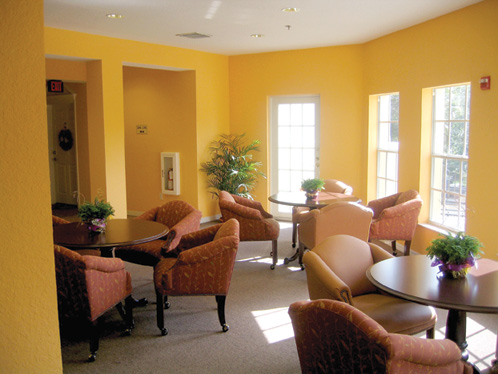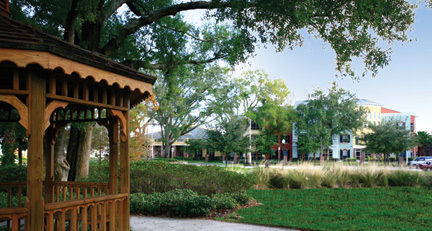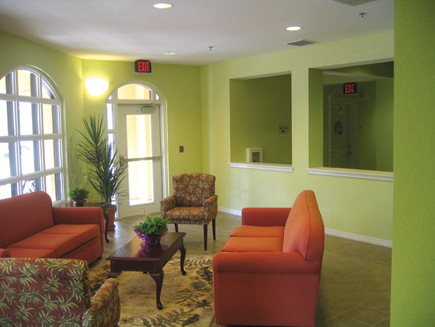
This senior generation is not coasting to the end. They are still on the journey, seeking new experiences and an expanded awareness. At this stage of life, today’s seniors have more time to indulge in areas of interest that they may have had to set aside in favor of work and family obligations.
Notwithstanding age in years, the senior today has a more youthful self-identity and aspires to a more engaged and active lifestyle.
Compared with the tastes of the emerging baby boomer population versus their predecessors, it is clear the design assumptions that were employed in the 1990s no longer work. In the ’90s, designers and residents favored traditional style, dark wood, and “vanilla” colors and textures.
These created exterior and interior impressions that look old, sedentary, and tired.
In contrast, baby boomers favor an environment that is lively and energetic. It needn’t be edgy, but it must be bright, with a measured degree of lightheartedness.
There is no single design aesthetic employed; instead, it should be an activating expression appropriate to the local community’s local design vernacular and population. When strong regional or local community identities exist, the environment should reflect these.
Landscaping Important To Feelings Of Contentment
A vibrant natural world brings energy. Rooms with great views, whether of nourished gardens or expansive vistas, engage the resident with the living world. Landscape, indoor and out, brings a healthy and enriching spirit to the community. Natural building materials and finishes offer a harmonious interface between space and place, advancing a fresh and integrated feel to the environment.
Such spaces bring brightness and pleasure to the individual, which is reflected in the quality of spirit they share while in spaces that elevate their mood. Remember, a well-cared-for landscape is a very powerful communicator of overall “caring.”
Plants don’t die: With proper care, they flourish. When residents and their families see well-tended grounds, they receive the message that staff care for residents as well.
Furnishing comfort determines the length of stay, and the posture in it determines the level of relaxation versus engagement. The ergonomics of the furniture need not only respect the mobility limitations that may exist but should also strive to position the user to lean into the activity of the common area and not withdraw by virtue of a sedentary posture.
Over-soft, reclining positions will advance fatigue and result in a drowsy manner, if not a tendency to sleep sitting. The more upright the seat (without sacrificing comfort), the more engaged and prolonged the interaction between individuals. Color and materials also communicate quality and cleanliness. Dusty and darker tones often create an impression that materials and finishes are soiled. Lighter, softer tones offer a more youthful feel even when applied to traditional interior décors.
Lighting Choices Critical
Lighting is often seen as a utility and not as a theatrical tool. However, with creative applications of lighting, the character of rooms can be made energetic or relaxing, comfortable for large groups or comfortable for just two, socially engaging or transient.
Lower levels of illumination are often used in large rooms to encourage small independent zones where a few might visit. The brighter the overall illumination, the more it is appropriate for a larger assembly of people who are interacting.
Often, lighting is measured on brightness and not on clarity. Lights that are too bright or lamps that are exposed can cause glare. The glare produces early eye fatigue and limits the ability to see beyond the intrusive illumination. Indirect lighting, more softly and uniformly cast, produces a better level of visual acuity and invites visual connection with others.
The avoidance of eye fatigue also invites a longer duration in areas where social interaction is encouraged.
Composing the décor with the ingredients of indoor planting, proper furniture, brightened colors, and creative lighting will result in residents feeling more lively and interactive and acting accordingly.
Activate Outdoor Living
If viewing the outdoors inspires the resident with beauty of the living world, then being outdoors ensures that outcome. Much depends on the area’s climate, but even in the northern and southern reaches of the United States, there are times of the year that are temperate, providing a welcome opportunity to get outside the four walls of home.

Yet, all too often, outdoor living spaces are designed for passive viewing, not active experience. This does little to further the goals of social interaction. Consider the following reflections.
- The most successful outdoor living areas are freely accessible. That begins with transparency. The more the indoor environment presents the outdoors as an extension of the same domain, the more the outside invites engagement. The more the outside is furnished and shaded to feel like a living space, the more it becomes an enhanced and expanded community living area. The more it is appointed with groupings and common features such as fire pits or TV, the more people will enjoy the space for extended periods of time.
- Even in urban environments where open space is often at a premium, outdoor space in the form of a rooftop terrace can become extremely popular with residents.
- An outdoor experience can also be fostered by selecting certain indoor areas to be all-season rooms that advance greater engagement with the outdoors. Sunrooms, solariums, and conservatories are but a few examples of indoor spaces that allow for outdoor experience even in inclement conditions.
Artificial daylighting, as well, will project a sunny day even with gray and overcast conditions.
- Gardening is the most popular outdoor activity in the country, regardless of age. Every senior living community should offer opportunities for residents to engage in the creative, spiritually fulfilling process of nurturing plants.
Raised planters provide easy access to gardening for people who cannot get down and up readily. A community garden can even provide food for the common kitchen, flowers for the table, and, most importantly, a common interest to share with others.
- A pool with a “roll-in” edge, especially if the pool is partially shaded with a canopy, invites use by people with a wide range of physical abilities and use of the amenity for greater periods of time throughout the day. The longer they enjoy the feature, the more social interaction results.
- A pet park where residents can walk and play with their dogs provides regular physical activity and a chance to get to meet other animal lovers.
- Multipurpose outdoor pavilions that can be used for cooking and dining expand the dining venues and change the character and spirit of the occasion.
- Indoor areas suitable for crafts, hobbies, and learning venues bring together individuals who share a common interest. A common interest or purpose is the core of a lasting acquaintance.
- Finally, consider landscaping. Avoid just considering the planter and shrub border. An investment in trees creates communities that age with dignity and ever-increasing value. As trees mature, they provide seasonal interest and form a canopy that offers shelter and charm. Well-shaded outdoor spaces become destinations—rooms without walls—which encourage prolonged interaction and sociable encounters.
 Integrate Safety, Security
Integrate Safety, Security
For social interaction to flow freely, the resident must feel safe and secure. They generally are, when housed in a proper environment, but that reality may still not be perceived.
The challenge in any planned community is to create an environment that feels protected without expressing it with hardened expressions like bars, gates, and obtrusive surveillance devices—an environment that suggests a home rather than a prison.
A community planning theory that grew out of New Urbanism (see
www.newurbanism.org) integrates safety and security measures that both function effectively and minimize the implication that a threat may prevail.
In part, it focuses on visibility, avoidance of blind corners, translucent rather than solid outdoor enclosures, and lighting that avoids bright sources or “hot spots” in favor of uniform and often indirect lighting sources.
At the front desk, use of a lower counter that provides for a fuller view of the attendant—better yet, a segmented desk that allows that attendant to move around the desk and greet a resident or visitor—projects a strong, friendly first impression.
Corridors can be intimidating environments. The addition of windows and natural lighting, the appointment of each unit door as if it were the “front stoop” of a private dwelling, and the occasional use of art and furniture that convey an impression of permanence rather than transience are features that bring a safe, secure feeling to the community space.
Return On Investment
For optimal benefit to residents and preferred return on investment to providers, designers must prioritize their focus on common areas that draw residents together in ways that cultivate connectivity.
Even within existing facilities, many of the principles of social engagement can be advanced with attention to detail and awareness of the objective.
As residents become active, engaged, and communicative, they invest in the place they call home. That investment generates durability in both their efforts to delay decline and their respective occupancy within the facility.
Thoughtful planning and design and the encouraged use of amenities not only attract residents and their families to a senior-living community, they enable providers to weave a social fabric that activates and engages residents in their community life.

Robert Koch, AIA, is a principal of Fugleberg Koch, an architecture, planning, urban design, and development consulting firm located in Winter Park, Fla. The firm’s residential portfolio includes mixed-use, urban infill, mid-rise, high-rise, direct-entry, senior living, workforce housing, and affordable-housing projects. Koch can be contacted at (800) 393-0595 or online at www.fugleberg koch.com/contact.php.